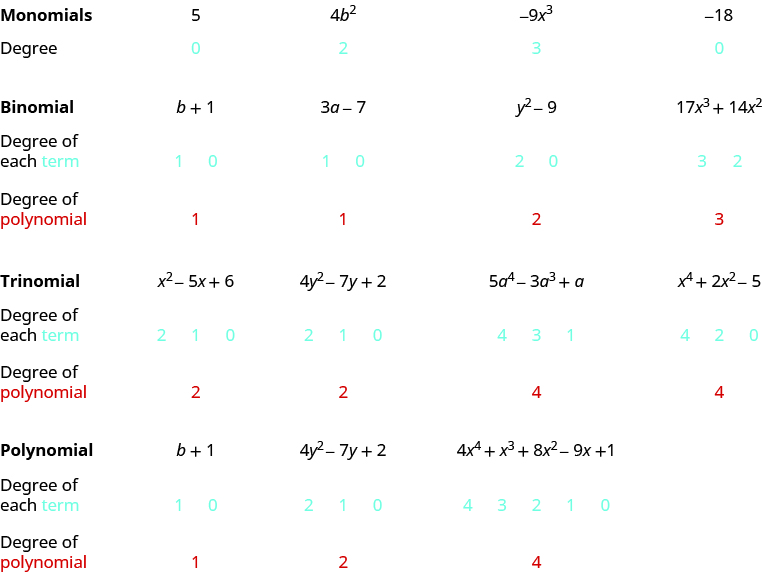Learning Outcomes
- Identify whether a polynomial is a monomial, binomial, or trinomial
- Determine the degree of a polynomial
- Add polynomials
- Subtract polynomials
- Evaluate a polynomial for integer values
Identify Polynomials, Monomials, Binomials, and Trinomials
In Evaluate, Simplify, and Translate Expressions, you learned that a term is a constant or the product of a constant and one or more variables. When it is of the form [latex]a{x}^{m}[/latex], where [latex]a[/latex] is a constant and [latex]m[/latex] is a whole number, it is called a monomial. A monomial, or a sum and/or difference of monomials, is called a polynomial.
Polynomials
polynomial—A monomial, or two or more monomials, combined by addition or subtraction
monomial—A polynomial with exactly one term
binomial— A polynomial with exactly two terms
trinomial—A polynomial with exactly three terms
Notice the roots:
- poly– means many
- mono– means one
- bi– means two
- tri– means three
Here are some examples of polynomials:
| Polynomial | [latex]b+1[/latex] | [latex]4{y}^{2}-7y+2[/latex] | [latex]5{x}^{5}-4{x}^{4}+{x}^{3}+8{x}^{2}-9x+1[/latex] |
| Monomial | [latex]5[/latex] | [latex]4{b}^{2}[/latex] | [latex]-9{x}^{3}[/latex] |
| Binomial | [latex]3a - 7[/latex] | [latex]{y}^{2}-9[/latex] | [latex]17{x}^{3}+14{x}^{2}[/latex] |
| Trinomial | [latex]{x}^{2}-5x+6[/latex] | [latex]4{y}^{2}-7y+2[/latex] | [latex]5{a}^{4}-3{a}^{3}+a[/latex] |
Notice that every monomial, binomial, and trinomial is also a polynomial. They are special members of the family of polynomials and so they have special names. We use the words ‘monomial’, ‘binomial’, and ‘trinomial’ when referring to these special polynomials and just call all the rest ‘polynomials’.
example
Determine whether each polynomial is a monomial, binomial, trinomial, or other polynomial:
1. [latex]8{x}^{2}-7x - 9[/latex]
2. [latex]-5{a}^{4}[/latex]
3. [latex]{x}^{4}-7{x}^{3}-6{x}^{2}+5x+2[/latex]
4. [latex]11 - 4{y}^{3}[/latex]
5. [latex]n[/latex]
Solution
| Polynomial | Number of terms | Type | |
|---|---|---|---|
| 1. | [latex]8{x}^{2}-7x - 9[/latex] | [latex]3[/latex] | Trinomial |
| 2. | [latex]-5{a}^{4}[/latex] | [latex]1[/latex] | Monomial |
| 3. | [latex]{x}^{4}-7{x}^{3}-6{x}^{2}+5x+2[/latex] | [latex]5[/latex] | Polynomial |
| 4. | [latex]11 - 4{y}^{3}[/latex] | [latex]2[/latex] | Binomial |
| 5. | [latex]n[/latex] | [latex]1[/latex] | Monomial |
try it
Determine the Degree of Polynomials
In this section, we will work with polynomials that have only one variable in each term. The degree of a polynomial and the degree of its terms are determined by the exponents of the variable.
A monomial that has no variable, just a constant, is a special case. The degree of a constant is [latex]0[/latex] —it has no variable.
Degree of a Polynomial
The degree of a term is the exponent of its variable.
The degree of a constant is [latex]0[/latex].
The degree of a polynomial is the highest degree of all its terms.
Let’s see how this works by looking at several polynomials. We’ll take it step by step, starting with monomials, and then progressing to polynomials with more terms.
Remember: Any base written without an exponent has an implied exponent of [latex]1[/latex].

example
Find the degree of the following polynomials:
1. [latex]4x[/latex]
2. [latex]3{x}^{3}-5x+7[/latex]
3. [latex]-11[/latex]
4. [latex]-6{x}^{2}+9x - 3[/latex]
5. [latex]8x+2[/latex]
try it
Working with polynomials is easier when you list the terms in descending order of degrees. When a polynomial is written this way, it is said to be in standard form. Look back at the polynomials in the previous example. Notice that they are all written in standard form. Get in the habit of writing the term with the highest degree first.
Add and Subtract Monomials
In The Language of Algebra, you simplified expressions by combining like terms. Adding and subtracting monomials is the same as combining like terms. Like terms must have the same variable with the same exponent. Recall that when combining like terms only the coefficients are combined, never the exponents.
example
Add: [latex]17{x}^{2}+6{x}^{2}[/latex].
try it
example
Subtract: [latex]11n-\left(-8n\right)[/latex].
try it
example
Simplify: [latex]{a}^{2}+4{b}^{2}-7{a}^{2}[/latex].
try it
Watch the following video for more examples of how to multiply polynomials.
Add and Subtract Polynomials
Adding and subtracting polynomials can be thought of as just adding and subtracting like terms. Look for like terms—those with the same variables with the same exponent. The Commutative Property allows us to rearrange the terms to put like terms together. It may also be helpful to underline, circle, or box like terms.
Example
Find the sum: [latex]\left(4{x}^{2}-5x+1\right)+\left(3{x}^{2}-8x - 9\right)[/latex].
try it
Parentheses are grouping symbols. When we add polynomials as we did in the last example, we can rewrite the expression without parentheses and then combine like terms. But when we subtract polynomials, we must be very careful with the signs.
example
Find the difference: [latex]\left(7{u}^{2}-5u+3\right)-\left(4{u}^{2}-2\right)[/latex].
try it
Exercises
Subtract: [latex]\left({m}^{2}-3m+8\right)[/latex] from [latex]\left(9{m}^{2}-7m+4\right)[/latex].
TRY IT
In the next video we show more examples of adding and subtracting polynomials.
Evaluate a Polynomial
In The Language of Algebra we evaluated expressions. Since polynomials are expressions, we’ll follow the same procedures to evaluate polynomials—substitute the given value for the variable into the polynomial, and then simplify.
example
Evaluate [latex]3{x}^{2}-9x+7[/latex] when
1. [latex]x=3[/latex]
2. [latex]x=-1[/latex]
Solution
| 1. [latex]x=3[/latex] | |
| [latex]3{x}^{2}-9x+7[/latex] | |
| Substitute [latex]3[/latex] for [latex]x[/latex] | [latex]3{\left(3\right)}^{2}-9\left(3\right)+7[/latex] |
| Simplify the expression with the exponent. | [latex]3\cdot 9 - 9\left(3\right)+7[/latex] |
| Multiply. | [latex]27 - 27+7[/latex] |
| Simplify. | [latex]7[/latex] |
| 2. [latex]x=-1[/latex] | |
| [latex]3{x}^{2}-9x+7[/latex] | |
| Substitute [latex]−1[/latex] for [latex]x[/latex] | [latex]3{\left(-1\right)}^{2}-9\left(-1\right)+7[/latex] |
| Simplify the expression with the exponent. | [latex]3\cdot 1 - 9\left(-1\right)+7[/latex] |
| Multiply. | [latex]3+9+7[/latex] |
| Simplify. | [latex]19[/latex] |
try it
The following video provides another example of how to evaluate a quadratic polynomial for a negative number.
example
The polynomial [latex]-16{t}^{2}+300[/latex] gives the height of an object [latex]t[/latex] seconds after it is dropped from a [latex]300[/latex] foot tall bridge. Find the height after [latex]t=3[/latex] seconds.
try it





